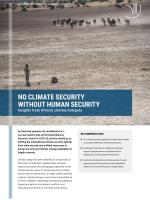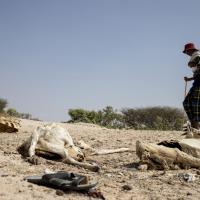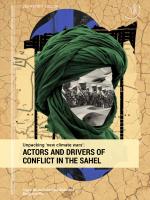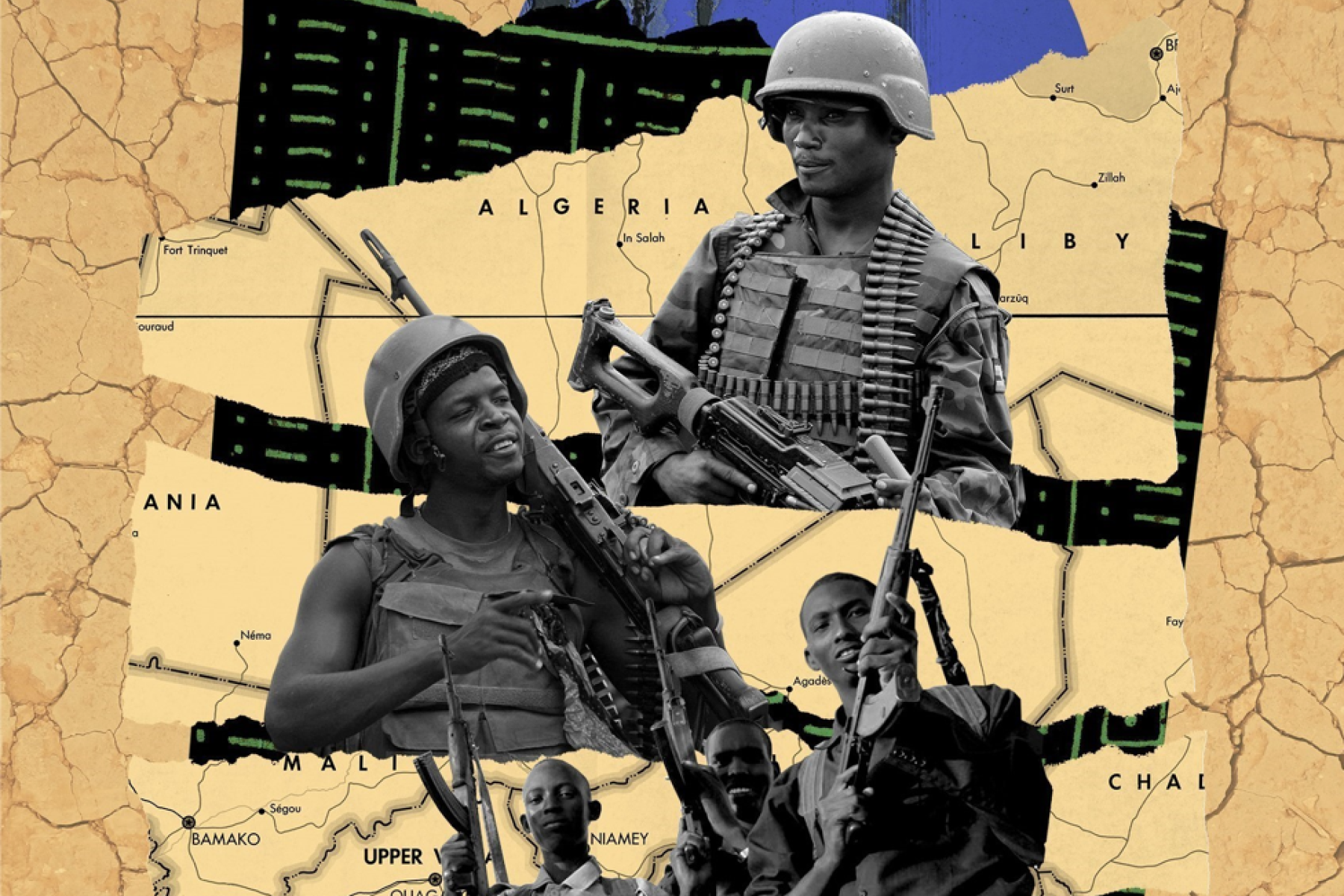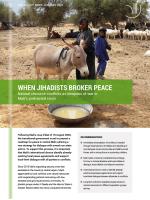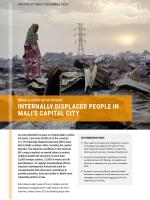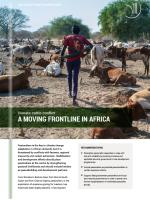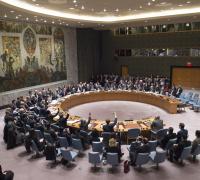No climate security without human security
- The climate security agenda on fragile states needs to prioritise livelihoods and human security
- Emphasis should be on making humanitarian support and prevention mechanisms fit for addressing climate change emergencies
- Denmark should promote climate justice through supporting conflict-sensitive climate adaptation initiatives and climate finance in fragile states
As Denmark prepares its candidature for a non-permanent seat at the United Nations Security Council in 2025-26, priority should go to shifting the international climate security agenda from state security and military responses to human security and climate change adaptation in fragile contexts.
Climate change has been identified as a key priority in Denmark’s contribution to global peace. However, experts and states have diverging perspectives on the climate security nexus, on whose security is at stake, and on what should be done. In fragile conflict affected contexts, climate change is commonly interpretated as a ‘threat multiplier,’ challenging international stability by triggering migration and resource conflicts, and expanding recruitment for non-state armed actors.
This framing reflects prevailing international security concerns but runs the risk of favouring state security and military responses at the expense of human security. Based on research on the Sahel and Horn of Africa – areas which are deemed fragile climate security “hotspots” – we argue for a broadened climate security agenda centred on addressing livelihood and security needs of populations.
Only a fraction of international climate finance flows for adaptation goes to conflict-affected contexts
The climate security nexus in fragile states: What is at stake?
The Horn of Africa and Sahel are commonly understood as hotbeds of climate insecurity. In September 2022, Secretary-General António Guterres dubbed the Sahel region a “global threat” to peace and security due to skyrocketing levels of armed conflict and rising insecurity increasingly associated with climate change.
There are important caveats to the framing of climate change as a conflict trigger, however. Most importantly, there is no clear evidence of a direct causal effect of climate change on armed conflict. This is not to deny that climate change interacts with conflict dynamics, but according to the 2022 IPCC Working Group II report “Compared to other socioeconomic factors the influence of climate on conflict is assessed as relatively weak.” Evidence from the Sahel and Africa’s Horn supports this conclusion. Here most alleged “climate conflicts” are grounded in long-term unequal distribution of rights and access to natural resources that link to corrupt state practices and changing regional security dynamics.
In turn, ongoing war is putting the regions under further stress. In central Mali, for example, conflict and insecurity currently aggravate food insecurity, as armed groups prevent people from cultivating their fields and accessing grazing areas. Human rights violations by both state and non state actors are causing mass displacement. According to UNHCR the number of internally displaced persons in the Sahel has increased tenfold from 217,000 in 2013 to more than 2.5 million in 2021.
Furthermore, food insecurity is a complex phenomenon that is not only affected by local conflict or rainfall fluctuations but also, crucially, by global market mechanisms and rising food prices, economic sanctions and political decision-making. The prevailing focus on state security and defence issues that underpin the current climate security agenda on fragile states, is apt to overlook these complexities, and underplay the direct link to livelihoods, and thereby to human security.
The complex relationship between climate and conflict does not imply that the issue of climate change should be left out of a forum like the UN Security Council. Yet, global responses to conflict and insecurity should focus on minimising harmful effects of climate change, considering the complexities at stake in the interplay between conflict and political fragility, while bearing in mind the link to livelihood. Upgraded humanitarian support mechanisms and a prioritisation of context-sensitive adaptation strategies should be central elements of international climate security responses.
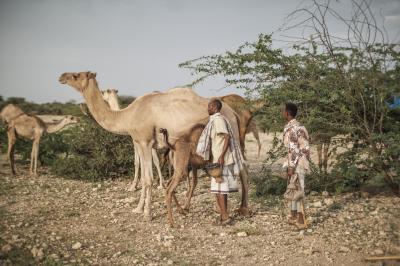
Making humanitarian responses fit for purpose
In Sahel as in Africa’s Horn, rural people’s livelihoods depend on rainfed agriculture and livestock rearing, which make them some of the world’s most vulnerable to climate-related stress. The catastrophic human consequences of climate change against a wider backdrop of regional armed conflict, international geopolitics and war are starkly illustrated by the acute food crisis in Somalia, where four consecutive rainy seasons have failed.
The confluence of COVID-19 and the war in Ukraine has severely aggravated the drought-induced livelihood crises in both Sahel and the Horn of Africa. Food prices hiked, humanitarian aid dropped, and UN supported initiatives to address the crises have remained underfunded. The new agreement, reached at the UN’s Climate Change Conference COP27, on creating a “loss and damage” fund, focused on assisting vulnerable countries hit by climate disasters, provides hope for a step-change. Yet, the need for upgrading humanitarian funding instruments, making them fit for purpose, is urgent. In the face of the current state of perpetual crises, failure to prioritize humanitarian support may add to another tipping point of displacement, conflict and fragility in places where local response mechanisms have reached their limits.
In Somalia and Somaliland, despite intractable war in the south, civil society has continued to find ways of supporting communities facing climate aggravated emergencies. With the growth of digital networks, community-based emergency support is mobilised domestically and in the international diaspora through WhatsApp groups and money transfer systems. More formalised initiatives involve state institutions.
In Somaliland’s pastoral regions, where climate adaptation is central on the political agenda, local governments and pastoralist communities collaborate to establish seasonal grazing reserves to allow regeneration of pastures. Related adaptation initiatives include investments in water conservation and the rise of commercial fodder production to support pastoralists during droughts.
Existing initiatives can and should be entry-points for external support. Yet it is crucial to be cognisant of the political nature and conflict potential of adaptation, and to integrate conflict sensitivity and effective consultation mechanisms directly into climate adaptation. Often external aid to increase water supply and food production has exacerbated conflicts when failing to take account of political context. This also highlights the need to take into account the nexus between resources scarcity and governance and move beyond technical fixes centred on scarcity as an isolated matter.
Investing in challenging but crucial climate adaptation in fragile states
In addition to humanitarian support, strengthening climate change adaptation is crucial. Yet, adaptation does not take centre stage in the prevailing climate security approaches to fragile states, partly due to overriding defence priorities and risk perceptions. There are several existing local climate adaptation initiatives. Historically, rural households in the Sahel and Africa’s Horn have used seasonal mobility and exchange of resources in the community to adapt to the harsh environments. But this requires trust within and between local communities – something which perpetual armed conflict has eroded. Nonetheless, while receiving scant attention, local institutions and actors, including in the most conflict-ridden contexts, have persistently devised a range of climate adaptation strategies.
The Danish government has decided to allocate an additional 100 million DKK to supporting climate change adaptation in fragile states. The new climate funds were part of Denmark’s Finance Act 2022, aimed at strengthening Denmark’s global climate efforts and work toward the goal that at least 60% of climate aid targets climate adaptation.
Local adaptation cannot stand alone, however. The current climate- and food emergencies in Somalia and the Sahel acutely illustrate the limits of local responses.
Conflict severely challenges the implementation of climate adaptation and finance initiatives. Yet, if risk aversion circumvents adaptation support, people in countries which experience the combined burdens of conflict, fragility and climate emergency, are left behind. The UN Security Council should focus on advancing tailor-made approaches to conflict sensitive climate adaptation, forge initiatives with combined climate and security benefits, and undertake more fine-grained contextual risks assessments. Following through on the pledge to advance climate justice, Denmark can take a lead in driving forward climate adaptation support, and ensuring the integration of conflict prevention mechanisms in adaptation programming.
This publication has received financial support from the Ministry of Foreign Affairs of Denmark. It reflects the views of the author(s) alone.
- Water governance
- Food and agriculture
- Land rights and investments
- Climate change and environment
- Defence and security policy
- Migration and development
- Inequality and poverty
- Development in practice
- Danish and European foreign policies
- Diplomacy and international organisations
- Peacebuilding and democratization
- Fragile states
DIIS Experts

